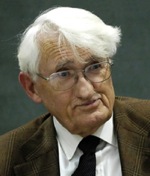A stern, unyielding version of Islam is replacing the kinder, gentler Islam of the Sufis in Pakistan.
Pervez Hoodbhoy in Newsline:
 Political leaders like Nawaz Sharif and Imran Khan have no words of solace for those who have suffered at the hands of Islamic extremists. Their tears are reserved exclusively for the victims of Predator drones, even if they are those who committed grave crimes against their own people. Terrorism, by definition, is an act only the Americans can commit.
Political leaders like Nawaz Sharif and Imran Khan have no words of solace for those who have suffered at the hands of Islamic extremists. Their tears are reserved exclusively for the victims of Predator drones, even if they are those who committed grave crimes against their own people. Terrorism, by definition, is an act only the Americans can commit.
What explains Pakistan’s collective masochism? To understand this, one needs to study the drastic social and cultural transformations that have rendered this country so completely different from what it was in earlier times.
For three decades, deep tectonic forces have been silently tearing Pakistan away from the Indian subcontinent and driving it towards the Arabian peninsula. This continental drift is not physical but cultural, driven by a belief that Pakistan must exchange its South Asian identity for an Arab-Muslim one. Grain by grain, the desert sands of Saudi Arabia are replacing the rich soil that had nurtured a magnificent Muslim culture in India for a thousand years. This culture produced Mughul architecture, the Taj Mahal, the poetry of Asadullah Khan Ghalib, and much more. Now a stern, unyielding version of Islam (Wahhabism) is replacing the kinder, gentler Islam of the Sufis and saints who had walked on this land for hundreds of years.
More here. [Thanks to Mehreen Jabbar.]
From The Telegraph:
 There’s something indecent about Jerry Hall – and it’s not the legs, platinum mane or sexually charged Tennessee Williams drawl. It’s the fact that at 53, the Texas-born model oozes contentment. Sacrilege, really, when you consider the current diktat that any woman nearing middle age should be preparing to live out her years mired in self-loathing. “A lot happens at 50,” Hall explains, “the best thing being that you just don’t care any more.” She tilts her head to one side and lowers heavily made-up lashes. “At 40, you still care. At 30, you care way too much – and your twenties are quite frankly a nightmare. Bring on 60, I say: just imagine the joy of having grandchildren.”
There’s something indecent about Jerry Hall – and it’s not the legs, platinum mane or sexually charged Tennessee Williams drawl. It’s the fact that at 53, the Texas-born model oozes contentment. Sacrilege, really, when you consider the current diktat that any woman nearing middle age should be preparing to live out her years mired in self-loathing. “A lot happens at 50,” Hall explains, “the best thing being that you just don’t care any more.” She tilts her head to one side and lowers heavily made-up lashes. “At 40, you still care. At 30, you care way too much – and your twenties are quite frankly a nightmare. Bring on 60, I say: just imagine the joy of having grandchildren.”
Released from her troubled nine-year marriage to serial philanderer Mick Jagger a decade ago, Hall, a mother of four – Elizabeth, 25, James, 24, Georgia May, 17, and Gabriel, 12 – has been busy living out plans that have been a lifetime in the making. She has completed an Open University course in Humanities and the Enlightenment and built up a theatre repertoire on Broadway and in London’s West End, where she has, for the past four months, been playing Miss September in Calendar Girls, a stage version of the hit 2003 film about the British Women’s Institute calendar. Bearing all this in mind, it’s just possible that the shelving of a £1 million “explosive” autobiography earlier this year might be down to time constraints, and not, as has been suggested, because Hall refused to dish the dirt on her ex-husband.
More here.
Sean Carroll in Cosmic Variance:
 This month’s issue of WIRED features a great story by Amy Wallace: “An Epidemic of Fear: How Panicked Parents Skipping Shots Endangers Us All.” It’s an overview of the anti-vaccination movement in the United States, a topic that should be very familiar to anyone who reads Discover’s baddest astronomer. At ScienceBlogs, Orac and Abel Pharmboy gives big thumbs-up to the article.
This month’s issue of WIRED features a great story by Amy Wallace: “An Epidemic of Fear: How Panicked Parents Skipping Shots Endangers Us All.” It’s an overview of the anti-vaccination movement in the United States, a topic that should be very familiar to anyone who reads Discover’s baddest astronomer. At ScienceBlogs, Orac and Abel Pharmboy gives big thumbs-up to the article.
The anti-vaccination movement is a little weird — they claim that vaccines, which are universally credited with wiping out smallpox and polio and other bad things, are responsible for causing autism and diabetes and other also-bad things, all just to make a buck for pharmaceutical companies. The underlying motivation seems to be a combination of the conviction that things must happen for a reason — if a child develops autism, there must be an enemy to blame — and a general distrust of science and technology. Certainly the pro-science point of view is fairly unequivocal; like any medicine, vaccines should be used properly, but they have done great good for the world and there are very real dangers of increased risk for epidemics if enough children stop receiving them. Good for WIRED for taking on the issue and publishing an uncompromisingly pro-science piece on it.
But the anti-vax movement is more than just committed; they’re pretty darn virulent. And since the article came out, author Amy Wallace has been subject to all sorts of attacks. She’s been documenting them on her Twitter feed, which I encourage you to check out.
More here.
From Scientific American:
 A fierce crustacean known as the peacock mantis shrimp has eyes so refined they can perceive polarized light, including information that is invisible to nearly every other member of the animal kingdom. Not only can the ocean dweller extract polarization information from light, it can do so when the light is circularly polarized—an ability unknown outside a few species of the order of stomatopods to which the peacock mantis belongs.
A fierce crustacean known as the peacock mantis shrimp has eyes so refined they can perceive polarized light, including information that is invisible to nearly every other member of the animal kingdom. Not only can the ocean dweller extract polarization information from light, it can do so when the light is circularly polarized—an ability unknown outside a few species of the order of stomatopods to which the peacock mantis belongs.
Unlike linearly polarized light, in which the electric field oscillates along a plane, circularly polarized light's field twists like a spiral spring as the ray propagates. Such light is not commonly reflected from animal bodies and so was long dismissed as a virtual nonfactor in physiology, but research last year showed that some stomatopods have the ability to discriminate circular polarization. A paper published online October 25 in Nature Photonics unpacks the mechanism behind the mantis shrimp's ability and concludes that its eyes handle circularly polarized light more effectively than man-made optical devices do. (Scientific American is part of the Nature Publishing Group.)
More here.
 According to a report released Monday by the American Institute of Religions, the Church of Scientology, once one of the fastest-growing religious organizations in the U.S., is steadily losing members to the much newer religion Fictionology.
According to a report released Monday by the American Institute of Religions, the Church of Scientology, once one of the fastest-growing religious organizations in the U.S., is steadily losing members to the much newer religion Fictionology.
“Unlike Scientology, which is based on empirically verifiable scientific tenets, Fictionology's central principles are essentially fairy tales with no connection to reality,” the AIR report read. “In short, Fictionology offers its followers a mythical belief system free from the cumbersome scientific method to which Scientology is hidebound.”
Created in 2003 by self-proclaimed messiah Bud Don Ellroy, Fictionology's principles were first outlined in the self-help paperback Imaginetics: The New Pipe-Dream Of Modern Mental Make-Believe.
Fictionology's central belief, that any imaginary construct can be incorporated into the church's ever-growing set of official doctrines, continues to gain popularity. Believers in Santa Claus, his elves, or the Tooth Fairy are permitted—even encouraged—to view them as deities. Even corporate mascots like the Kool-Aid Man are valid objects of Fictionological worship.
“My personal savior is Batman,” said Beverly Hills plastic surgeon Greg Jurgenson. “My wife chooses to follow the teachings of the Gilmore Girls. Of course, we are still beginners. Some advanced-level Fictionologists have total knowledge of every lifetime they have ever lived for the last 80 trillion years.”
More here.
Randy Cohen in the New York Times Magazine:
 We do accord special status to religious groups, even writing it into our Constitution. Some actions that are generally forbidden are permitted if undertaken as a religious obligation: for instance, Sikh transit workers in New York may wear turbans. But not everything goes. Polygamy is outlawed. Nor would we allow human sacrifice, even if requested by a deeply observant Aztec. That is, we do not regard these things uncritically. And remember: it is not just religious practice but free expression that the Constitution protects. To muffle our discussion of religiously motivated acts is to dilute the discourse that is essential to democracy.
We do accord special status to religious groups, even writing it into our Constitution. Some actions that are generally forbidden are permitted if undertaken as a religious obligation: for instance, Sikh transit workers in New York may wear turbans. But not everything goes. Polygamy is outlawed. Nor would we allow human sacrifice, even if requested by a deeply observant Aztec. That is, we do not regard these things uncritically. And remember: it is not just religious practice but free expression that the Constitution protects. To muffle our discussion of religiously motivated acts is to dilute the discourse that is essential to democracy.
And so it is disheartening that the editorial pages of our most important newspapers did not castigate the Vatican’s invitation to misogyny and homophobia. Some blogs did so. Daily Kos headlined its coverage, “Vatican Welcomes Bigoted Anglicans.” But the discussion provided by, say, network news barely rose above the demure. That’s not courtesy; it’s cowardice. Perhaps the networks fear being charged with anti-Catholic bias. This is not an unreasonable concern. When I reproved that real estate agent, my surname was no shield against accusations of anti-Semitism. But surely it is possible to disagree respectfully. To criticize a particular practice of Orthodox Jews need not be anti-Semitism. To denounce this Vatican policy need not be anti-Catholic bigotry. Criticism is not contempt.
More here. [Thanks to Greg Segraves.]
Tuesday, October 27, 2009

I can’t stop watching the film clip of Anne Frank. Ever since the Anne Frank House museum posted it on their new Anne Frank YouTube channel a few weeks ago, I have watched it again and again. I must have watched it a hundred times. It is 20 seconds of shaky, black-and-white silence, in which Anne Frank appears at a window on a summer day in 1941. It is the only known film of Anne Frank. Only, it’s not a film about Anne Frank. At least not intentionally. The stars of the film are a newlywed couple, walking out of the house next door. The bride carries a huge bouquet of flowers and wears a modest skirt suit. She holds the arm of a lanky groom, who dons a top hat and tails. They smile. The street gathers to watch them, the windows in the surrounding buildings fill with onlookers. The film’s guest star is Merwedeplein, the street in Amsterdam where the Frank family lived before they went into hiding at 263 Prinsengracht — now known as the Secret Annex — the following summer of 1942. It’s a clear day on Merwedeplein and everything seems as it should: little girls hold their mothers’ hands, teenage boys ride bicycles, cars whiz past a nearby park. It’s a time when the Jews of Holland were only being deported in handfuls, and there’s no sign at all of a country living under occupation.
more from Stefany Anne Golberg at The Smart Set here.

Americans familiar with the long and bitter battle over the teaching of evolution in our schools likely have a set of images of what creationism looks like: from the Scopes trial, and its dramatization in “Inherit the Wind,” to more recent battles over textbooks on school boards in Kansas and Georgia and in federal court in Pennsylvania. The doctrine of creationism, and its less explicitly religious cousin intelligent design, are extensively developed counter-narratives of the origin of life on Earth, fed by Christian concerns and shaped by Christian beliefs. In its more extreme forms, creationist thought is guided by a faith in the inerrancy of the language of the Book of Genesis, so that some creationists see in the fossil record evidence that Noah must have herded dinosaurs onto his ark along with the rest of creation. But there is another creationist movement whose influence is growing, and which is fueling challenges to science in countries where Christianity has little sway: Islamic creationism. Campaigners in countries like Turkey, Lebanon, Egypt, and Indonesia have fought the teaching of evolution in schools there, sometimes with great success. Creationist conferences have been held in Pakistan, and moderate Islamic clerics are on record publicly condemning Darwin’s ideas. A recent study of Muslim university students in the Netherlands showed that most rejected evolution. And driven in part by a mysterious Turkish publishing organization, Islamic creationism books are hot sellers at bookstores throughout the Muslim world.
more from Drake Bennett at The Boston Globe here.
 Charles Taylor on Jürgen Habermas:
Charles Taylor on Jürgen Habermas:
Jürgen Habermas is known in the world of analytic philosophy primarily as a moral and political philosopher. He has striven against a slide which has often seemed plausible and tempting for modern thinkers, that towards a certain relativism or subjectivism in morals. The difficulty of establishing firm ethical conclusions in the midst of vigorous debate among rival doctrines, particularly when these disputes are contrasted to those among natural scientists can all too easily push us to the conclusion that there is no fact of the matter here, that ethical doctrines are not a matter of knowledge, but only of emotional reaction or subjective projection, that the issues here are not cognitive.
Habermas from the very beginning set his face against these non-cognitivist views. There can be ethical knowledge. But he wished also to break with a long-hallowed notion of what this knowledge must consist in, that which we find in the traditions which go back to Plato and Aristotle. According to these, ethical knowledge has for its object human nature, or the nature of things. In other words, it is grounded in some normative picture of what humans are like, or else of their place in the universe. According to Habermas, it was the discredit of these “metaphysical” views which gave colour to non-cognitivism in the first place. In order to refute subjectivism, morality needs another kind of rational basis.
The alternative route which he explored was that which makes the rationality of ethical conclusions a function of the rationality of the deliberation which produces them. A deliberation is rational if it meets certain formal requirements. This is, of course, the route which was pioneered by Kant. But Habermas made a revolutionary change in this tradition. Whereas for Kant the principal criterion of a rational and therefore defensible deliberation was that it was sought universalizable maxims, for Habermas the very notion of deliberation is transformed.
 Greg Boustead in Seed:
Greg Boustead in Seed:
[Luke] Jerram creates sculptures, installations, soundscapes, and live arts projects that investigate the mysterious process of how we construct inner worlds from objective reality. His work is inspired by such disparate areas of research as biology, acoustic science, sleep research, ecology, and neural pathways.
An ongoing theme of Jerram’s work is the animation of otherwise hidden phenomenon. Exploring the Moon’s invisible pull in his installation “Tide,” Jerram rigged a gravity meter to three water-filled globes, turning data from the meter into a resonating chorus based on Kepler’s theories of “music of the spheres.” In “Retinal Memory Volume,” Jerram uses light to exploit viewers’ retinal afterimages to construct ephemeral ghost-like sculptures.
On a lark, Jerram started looking at little creatures through borrowed light microscopes and via raw images from electron microscopy. He was amazed by the invisible world he witnessed, but when he compared what he saw to processed EM photographs and scientific drawings, they didn’t resemble his “beautiful translucent animals.”
 Via Andrew Sullivan, Scott Horton in Harper's:
Via Andrew Sullivan, Scott Horton in Harper's:
In 1980, Chingiz Aitmatov dedicated his essential novel, The Day Lasts More Than a Hundred Years (И дольше века длится день), to his father, whom he barely remembered. In this moving and powerful work, he presents a core theme: the dangers a society faces when it forgets its past, being subject instead to a counterfeit narrative designed to suit some political purpose. Such a society, Aitmatov argues, faces a bleak future. Battling the Soviet censors at every step, Aitmatov was presenting a critical view of the legacy of Soviet rule in Central Asia and his native Kyrgyzstan. But the novel shows how heavily the fate of his father hung over Aitmatov. A leading intellectual and advocate of nationalist ideas, though not an overt opponent of the Communists, Törökul Aitmatov had been arrested, transported to Moscow, and charged with “bourgeois nationalist” tendencies in 1937, when Chingiz was nine years old. The family was informed that he had been sentenced to prison camp “without right of correspondence,” meaning his family had no right to know of his whereabouts or seek to communicate with him. They feared the worst, but they had no way of knowing. The lack of certainty about his fate was a torment.
Then, late in 1991, something extraordinary happened. After the Soviet Union cracked and shattered in the wake of a failed putsch against President Mikhail Gorbachev, a woman appeared in a Bishkek police station with a riveting tale. “Is it safe now?” she asked. “Is Communism finally over?” Her father had been the custodian of a site in the foothills south of the capital since the 1930s, she explained. He had been sworn to absolute secrecy by the NKVD, the forerunner of the KGB. He had faithfully (and fearfully) kept that secret. But on his deathbed, he confided it to his daughter. “When the terror is over, when it is finally safe, tell them about it.” He told her, “the people must know.”
Autumn
They brought me a quilled, yellow dahlia,
Opulent, flaunting.
Round gold
Flung out of a pale green stalk.
Round, ripe gold
Of maturity,
Meticulously frilled and flaming,
A fire-ball of proclamation:
Fecundity decked in staring yellow
For all the world to see.
They brought a quilled, yellow dahlia,
To me who am barren
Shall I send it to you,
You who have taken with you
All I once possessed?
By Amy Lowell
from No More Masks; Anchor Books, 1973
Shahid Javed Burki in Dawn:
 Let me quote at length from a recent article by the journalist Thomas L. Friedman who has written extensively on the developing world, especially on Muslim countries. ‘In places like Egypt, Syria, Saudi Arabia, Afghanistan or Pakistan you have violent religious extremist movements fighting with state security services. … And while the regimes in these countries are committed to crushing their extremists, they rarely take on their extremist ideas by offering progressive alternatives. And when these extremists aim elsewhere … these regimes are indifferent. That is why there is no true war of ideas inside these countries — just a war.’
Let me quote at length from a recent article by the journalist Thomas L. Friedman who has written extensively on the developing world, especially on Muslim countries. ‘In places like Egypt, Syria, Saudi Arabia, Afghanistan or Pakistan you have violent religious extremist movements fighting with state security services. … And while the regimes in these countries are committed to crushing their extremists, they rarely take on their extremist ideas by offering progressive alternatives. And when these extremists aim elsewhere … these regimes are indifferent. That is why there is no true war of ideas inside these countries — just a war.’
This is a correct and insightful observation. ‘These states are not promoting an inclusive and tolerant interpretation of Islam that could be the foundation of people power,’ Friedman continues.
Pakistan, unlike the countries on Friedman’s list has had a ‘people power’ movement when the lawyers demonstrated that by acting with courage and resolution, they could bring about more than regime change. They could also force a strong executive to begin to show respect to the judiciary and its opinions. The same people power needs to be mobilised to rescue religion from the clutches of the extremists.
More here.
From Science:
 With its wrinkled skin and bucked teeth, the naked mole rat isn't going to win any beauty contests. But the burrowing, desert rodent is exceptional in another way: It doesn't get cancer. The naked mole rat's cells hate to be crowded, it turns out, so they stop growing before they can form tumors. The details could someday lead to a new strategy for treating cancer in people. In search of clues to aging, cell biologists Vera Gorbunova, Andrei Seluanov, and colleagues at the University of Rochester have been comparing rodents that vary in size and life span, from mice to beavers. The naked mole rat stands out because it's small yet can live more than 28 years–seven times as long as a house mouse. Resistance to cancer could be a major factor; whereas most laboratory mice and rats die from the disease, it has never been observed in naked mole rats.
With its wrinkled skin and bucked teeth, the naked mole rat isn't going to win any beauty contests. But the burrowing, desert rodent is exceptional in another way: It doesn't get cancer. The naked mole rat's cells hate to be crowded, it turns out, so they stop growing before they can form tumors. The details could someday lead to a new strategy for treating cancer in people. In search of clues to aging, cell biologists Vera Gorbunova, Andrei Seluanov, and colleagues at the University of Rochester have been comparing rodents that vary in size and life span, from mice to beavers. The naked mole rat stands out because it's small yet can live more than 28 years–seven times as long as a house mouse. Resistance to cancer could be a major factor; whereas most laboratory mice and rats die from the disease, it has never been observed in naked mole rats.
Gorbunova's team looked at the mole rat's cells for an answer. Normal human and mouse cells will grow and divide in a petri dish until they mash tightly against one another in a single, dense layer–a mechanism known as “contact inhibition.” Naked mole rat cells are even more sensitive to their neighbors, the researchers found. The cells stop growing as soon as they touch. The strategy likely helps keep the rodents cancer-free, as contact inhibition fails in cancerous cells, causing them to pile up.
More here.
Gina Kolata in The New York Times:
 Call it the arrow of cancer. Like the arrow of time, it was supposed to point in one direction. Cancers grew and worsened. But as a paper in The Journal of the American Medical Association noted last week, data from more than two decades of screening for breast and prostate cancer call that view into question. Besides finding tumors that would be lethal if left untreated, screening appears to be finding many small tumors that would not be a problem if they were left alone, undiscovered by screening. They were destined to stop growing on their own or shrink, or even, at least in the case of some breast cancers, disappear.
Call it the arrow of cancer. Like the arrow of time, it was supposed to point in one direction. Cancers grew and worsened. But as a paper in The Journal of the American Medical Association noted last week, data from more than two decades of screening for breast and prostate cancer call that view into question. Besides finding tumors that would be lethal if left untreated, screening appears to be finding many small tumors that would not be a problem if they were left alone, undiscovered by screening. They were destined to stop growing on their own or shrink, or even, at least in the case of some breast cancers, disappear.
“The old view is that cancer is a linear process,” said Dr. Barnett Kramer, associate director for disease prevention at the National Institutes of Health. “A cell acquired a mutation, and little by little it acquired more and more mutations. Mutations are not supposed to revert spontaneously.” So, Dr. Kramer said, the image was “an arrow that moved in one direction.” But now, he added, it is becoming increasingly clear that cancers require more than mutations to progress. They need the cooperation of surrounding cells and even, he said, “the whole organism, the person,” whose immune system or hormone levels, for example, can squelch or fuel a tumor.
Cancer, Dr. Kramer said, is a dynamic process.
More here.
Monday, October 26, 2009

Luke Jerram. H1N1. 2009
Glass sculpture; 25 cm.
More here and here.
Sunday, October 25, 2009
 Julian Sanchez on the depressing reauthorization of the Patriot Act:
Julian Sanchez on the depressing reauthorization of the Patriot Act:
We know the rules by now, the strange conventions and stilted Kabuki scripts that govern our cartoon facsimile of a national security debate. The Obama administration makes vague, reassuring noises about constraining executive power and protecting civil liberties, but then merrily adopts whatever appalling policy George W. Bush put in place. Conservatives hit the panic button on the right-wing noise machine anyway, keeping the delicate ecosystem in balance by creating the false impression that something has changed. We've watched the formula play out with Guantánamo Bay, torture prosecutions and the invocation of “state secrets.” We appear to be on the verge of doing the same with national security surveillance.
Last week, the Senate Judiciary Committee seemed to abandon hope of bringing any real change to the Patriot Act. A lopsided and depressingly bipartisan majority approved legislation that would reauthorize a series of expanded surveillance powers set to expire at the end of the year. Several senators had proposed that reauthorization be wedded to safeguards designed to protect the privacy of innocent Americans from indiscriminate data dragnets–but behind-the-scenes maneuvering by the Obama administration ensured that even the most modest of these were stripped from the final bill now being sent to the full Senate.
Via Brad Delong, over at the Remarque Institute, a video of the lecture by Judt, who is sadly afflicted with amyotrophic lateral sclerosis, or Lou Gehrig's disease.
Political leaders like Nawaz Sharif and Imran Khan have no words of solace for those who have suffered at the hands of Islamic extremists. Their tears are reserved exclusively for the victims of Predator drones, even if they are those who committed grave crimes against their own people. Terrorism, by definition, is an act only the Americans can commit.
